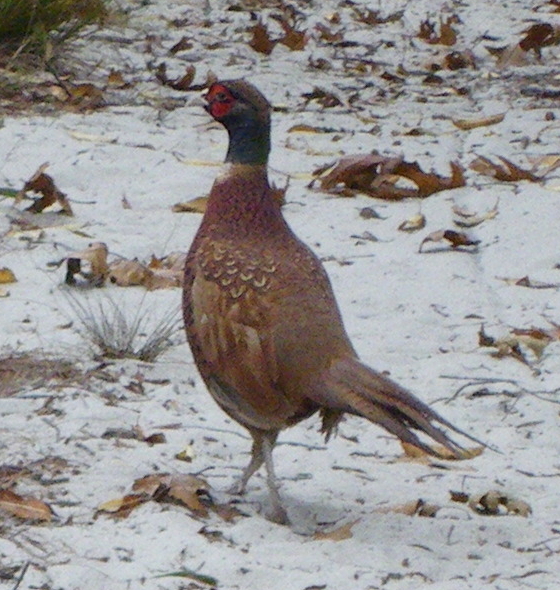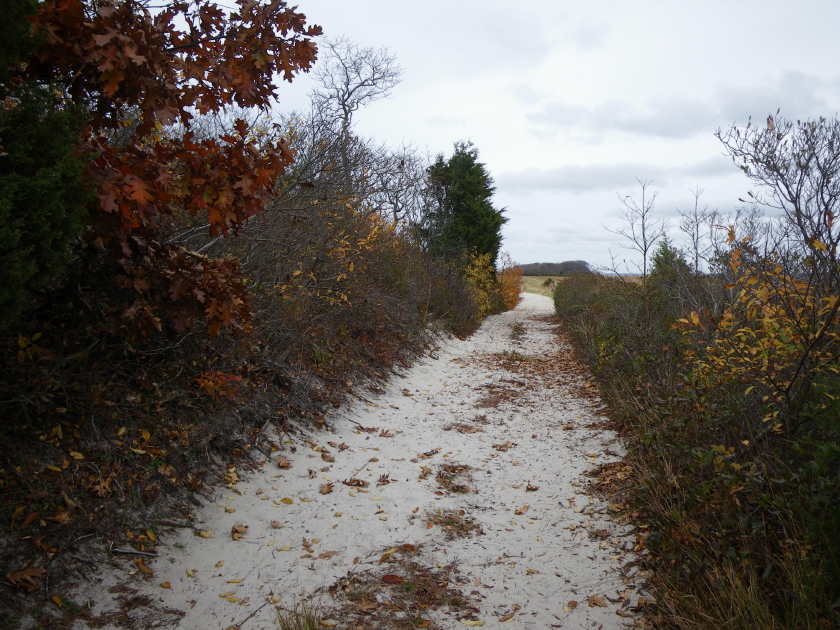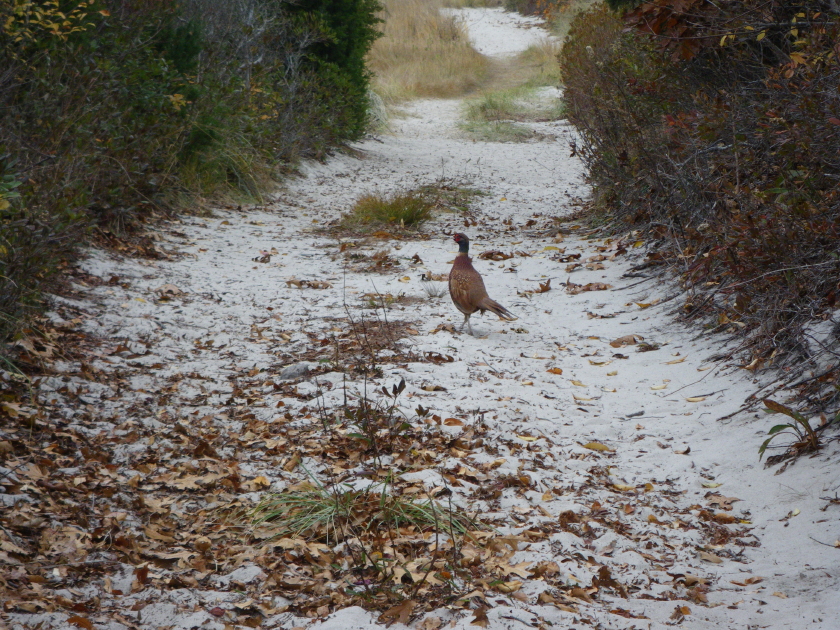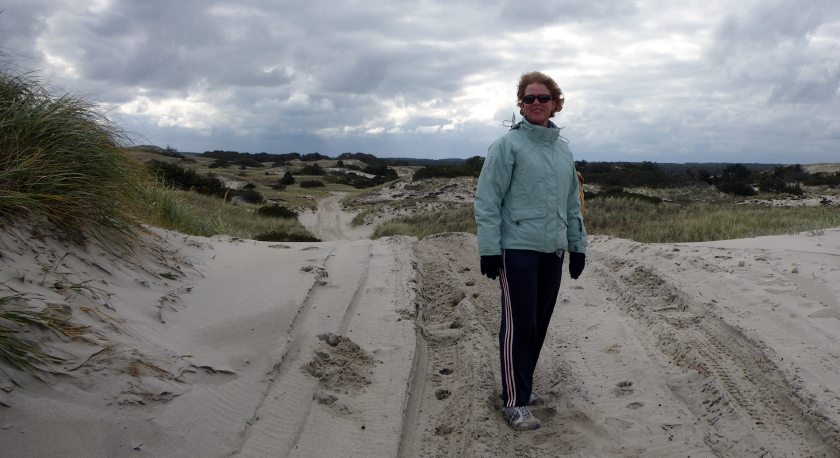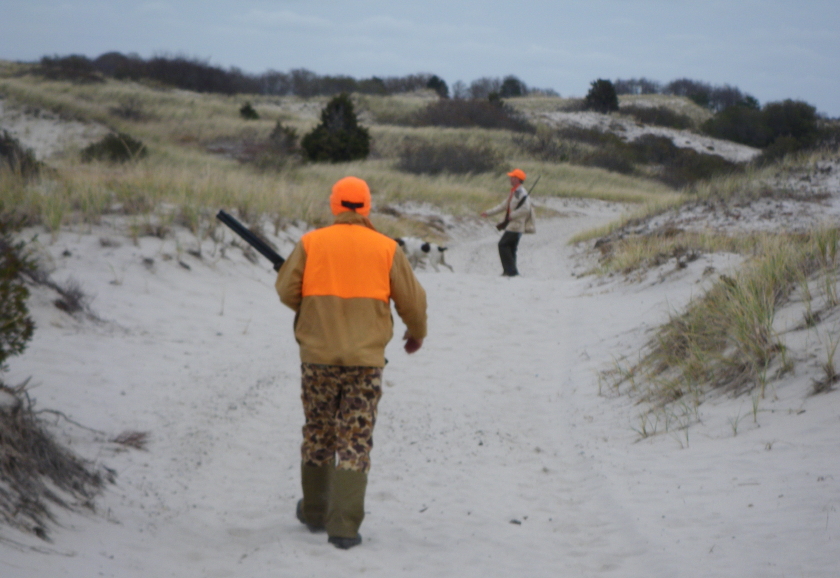Phil the Ring Necked Pheasant (Phasianus colchicus)
Whatever one’s personal viewpoint on hunting and fishing, and most of us exhibit a complex set of contradictory and complementary opinions on these topics, pheasant hunting season on Cape Cod magnifies these feelings. According to the Humane Society of the United States (see Cape Cod National Seashore “The Killing Fields“), ring necked pheasants (Phasianus colchicus) are not natives of Cape Cod, but of Asia.  They are farm raised off Cape and “transported weekly in Massachusetts state-owned trucks and unceremoniously dumped into the cool night air in stumpy forests of scrub pine and scrub oak.” According to the Humane Society, these animals “lack the basic skills to survive in this foreign habitat.” Consequently, some say pheasants offer an easy shot for beginners who may go on to develop into lifelong hunters.
Salt Marsh Trail at Sandy Neck Park, Barnstable
Several days ago the Turtle Journal Team visited Sandy Neck Park in Barnstable. The barrier beach and dunes protect the expansive salt marsh ecosystem of Barnstable Harbor which hosts the second largest population of threatened diamondback terrapins in Massachusetts (and perhaps all of New England). The salt marsh trail falls between nesting dunes on the north (left) and salt marsh on the south (right). Walking this road in September and October, you can be guaranteed to encounter a terrapin hatchling scrambling from its nest into the safety of the salt marsh nursery habitat … or at least sets of hatchling tracks that evidence babies that have recently crossed the dirt road.
Ring Necked Pheasant Runs onto Trail
Instead of a hatchling we were surprised to encounter Phil, a very nervous ring necked pheasant, scurrying along the salt marsh trail. When Phil saw us, he slipped into the dense vegetation to hide … as quietly as a bulldozer with backup alarm blaring. Since that tactic obviously wasn’t working, Phil jumped back onto the dirt road and sped down the path like a bowlegged roadrunner stuck in first gear.
Pheasant Hunting Season through November 28th
We remembered the sign we had glanced on entering the back trail and wondered whether Phil would be able to acclimate to this foreign environment before hunters and dogs chased him down and flushed him out for a clear shot. Heck, his amateurish evasive skills placed him face to face with the Turtle Journal Team for long enough for us to get a dozen close-up “shots” and to stare him eyeball to eyeball. There’s almost no dense cover to provide safety and camouflage for a non-native ring-necked pheasant.
Sue Wieber Nourse at Sandy Neck Park
We left Phil to his own devices and privacy as we crossed over the dunes to the bayside beach to search for stranded sea turtles at high tide. We forgot about our friend Phil as we enjoyed the stark beauty of Sandy Neck in mid November.
Hunters and Dog Scouring the Scrub Brush for Phil
Tranquility soon faded as bright orange gear dotted the horizon and a barking dog zigzagged across the dunes scouring the terrain for scent of Phil. As we proceeded to the bayside, more hunters appeared on dune tops and more dogs howled to the chase. We wondered how poor disoriented Phil had survived this long into the day and wondered if he’d ever see another night. In fact, we even worried a bit about ourselves as the lone non-hunters crossing the dunes without bright orange gear.
More Traditional Thanksgiving Prey
Native American Wild Turkey
A more traditional Thanksgiving prey and a wiley critter that can hold its own in its native habitat is the American wild turkey, Ben Franklin’s nominee as the emblematic symbol for the fledgling United States of America. Ben thought eagles paled in the face of a brave, valient American turkey. At least a wild turkey understands the Cape Cod ecosystem and wouldn’t get caught dead (or more preferably alive) in a barren barrier dune. Then again, we don’t dump wild turkeys into foreign habitats in the … excuse the phrase … dead of night.
We’d like to celebrate Thanksgiving with a look back at last fall when Turtle Journal posted several articles on our native wild turkeys. We’ve seen a lot of turkeys this season, too, but they’ve managed to avoid that perfect “traffic stopping moment” documented below.
Happy Thanksgiving from the entire Turtle Journal Family. We wish you another year of discovery. We hope you’ll join us in the joy of saving the world, just one species at a time … turtle, ocean sunfish, harbor seal, pilot whale, wild turkey, channel whelk, nine-spotted ladybug or even ring necked pheasant. If it crawls, swims, flies, slithers, scampers, hops or just exists, it’s worth saving.
